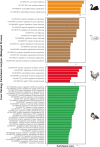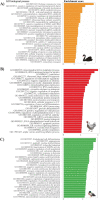The swan genome and transcriptome, it is not all black and white
- PMID: 36683094
- PMCID: PMC9867998
- DOI: 10.1186/s13059-022-02838-0
The swan genome and transcriptome, it is not all black and white
Abstract
Background: The Australian black swan (Cygnus atratus) is an iconic species with contrasting plumage to that of the closely related northern hemisphere white swans. The relative geographic isolation of the black swan may have resulted in a limited immune repertoire and increased susceptibility to infectious diseases, notably infectious diseases from which Australia has been largely shielded. Unlike mallard ducks and the mute swan (Cygnus olor), the black swan is extremely sensitive to highly pathogenic avian influenza. Understanding this susceptibility has been impaired by the absence of any available swan genome and transcriptome information.
Results: Here, we generate the first chromosome-length black and mute swan genomes annotated with transcriptome data, all using long-read based pipelines generated for vertebrate species. We use these genomes and transcriptomes to show that unlike other wild waterfowl, black swans lack an expanded immune gene repertoire, lack a key viral pattern-recognition receptor in endothelial cells and mount a poorly controlled inflammatory response to highly pathogenic avian influenza. We also implicate genetic differences in SLC45A2 gene in the iconic plumage of the black swan.
Conclusion: Together, these data suggest that the immune system of the black swan is such that should any avian viral infection become established in its native habitat, the black swan would be in a significant peril.
Keywords: Black swan; Genomes; Virology.
© 2023. The Author(s).
Conflict of interest statement
KRS is a consultant for Sanofi, Roche, and NovoNordisk. The opinions and data presented in this manuscript are of the authors and are independent of these relationships. The other authors declare no competing interests.
Figures





References
-
- van der Hoek, G. Israel: Avian Flu H5N8 in a Zoo and in Poultry - Media - OIE reports. Israel: Avian Flu H5N8 in a Zoo and in Poultry - Media - OIE reports. 2020. https://flutrackers.com/forum/forum/animal-diseases-of-concern-excludes-....
Publication types
MeSH terms
Grants and funding
LinkOut - more resources
Full Text Sources
Medical

